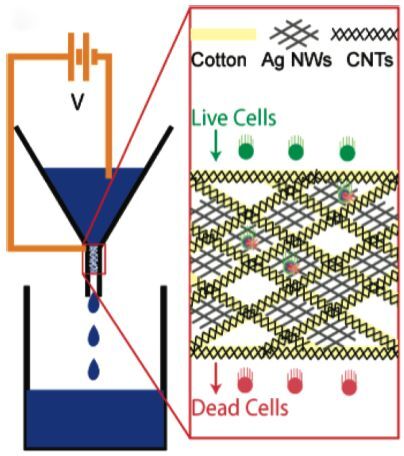Yi Cui, an Assistant Professor of Material Science and Engineering at Stanford University, has invented quite the water filter. It’s inexpensive, is very resistant to clogging, and uses much less electricity than systems that require the water to be pumped through them. It also kills bacteria, as opposed to just trapping them, which is all that many existing systems do.
Cui and his Stanford colleagues started with a basic cotton filter, as the material is cheap, widely-available and robust. Next, they covered it with sub-microscopic silver nanowires, as silver nanoparticles are well-known for their antibacterial qualities. They then added a layer of carbon nanotubes (CNTs) to increase the filter’s electrical conductivity, as electricity is also known to be lethal to bacteria. Finally, they experimented with running various strengths of electrical currents through the device, eventually settling at 20 volts.
When subjected to a 1 liter-per-hour gravity-fed stream of E. coli-tainted water, the water flowed through the filter relatively quickly and easily, due to its large pores – at tens to hundreds of micrometers in width, the pores are much wider than individual bacterium, and much wider than the pores of most filtering media. This should minimize occurrences of the filter becoming clogged with bacterial matter, a condition known as biofouling.

After samples of the filtered water had been left in agar dishes overnight, it was found that up to 98 percent of the bacteria had been killed. Given the water’s flow rate, it was calculated that the bacteria only needed to be in the filter for a little over one second for lethal exposure to occur. A combination of the silver, the electrical field, and/or changes in the water chemistry caused by the electricity were responsible, although the scientists are still trying to figure out just how much of a role each of those factors played.
The researchers are now investigating how effective the material is at killing other microorganisms, and whether or not trace silver and CNT residue in the filtered water is cause for concern. They are also looking into using the filter for purifying air, foods and pharmaceuticals.
The research was recently published in the journal Nano Letters.





